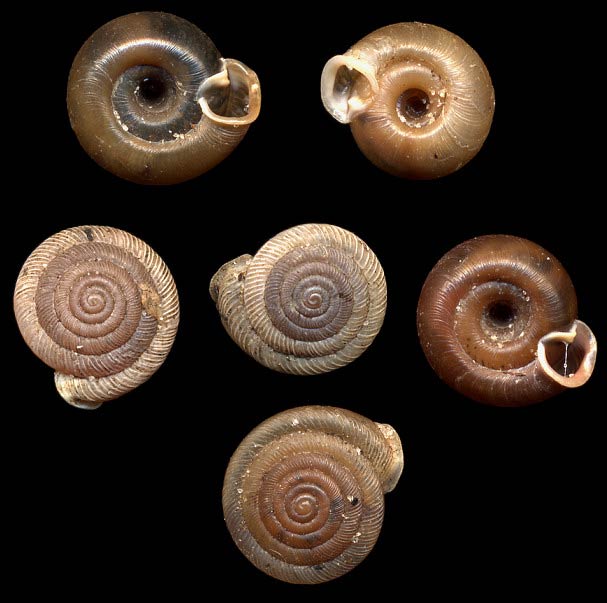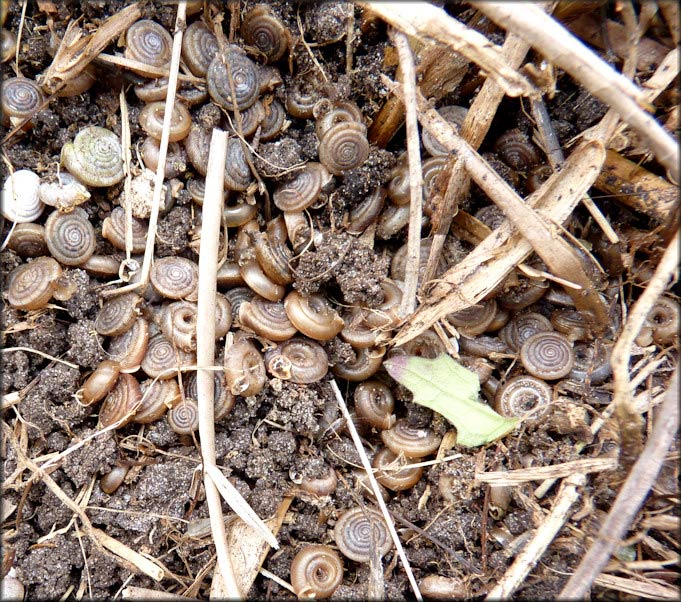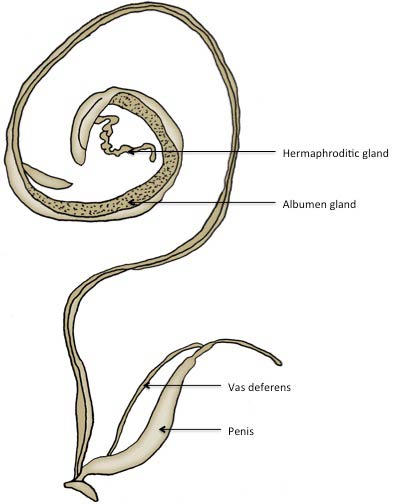Polygyra cereolus
|
Polygyra cereolus. (Photo: © B. Frank, Jacksonville) |
|
Polygyra cereolus. (Photo: © B. Frank, Jacksonville) |
|
Polygyra cereolus. (Photo: © B. Frank, Jacksonville) |
|
Polygyra cereolus: genitalia. (Photo: © J. White-McLean, U.F.) |
Family
Polygyridae
Species
Polygyra cereolus (Muhlfeld, 1816)
Common name
Southern flatcone snail
Description
There is considerable variation in the shellShell:
A hard, inflexible, calcareous or chitinous structure that vary in size and may either completely encasing the animal, covering some part of it or be internal.
size of Polygyra cereolus. The heightHeight:
The height of the shell is a measure of the distance between the apex and the most basal part of the shell OR the measurement taken from the apex of the shell to the base, when measured parallel to the axis of the shell.
ranges from 3.5-4.6 mm and the diameter ranges from 11.5-18.2 mm. The number of whorlsWhorls:
Pleural of whorl. A whorl is a complete spiral turn/growth of the shell of a mollusc. The whorls are counted from the apex outwards.
for this species also varies from 7-9. The discoidal shellShell:
A hard, inflexible, calcareous or chitinous structure that vary in size and may either completely encasing the animal, covering some part of it or be internal.
is white with radial streaks or spots of gray or light brown on the baseBase:
This is the lower or underside of the shell; opposite of apical.
, giving the shellShell:
A hard, inflexible, calcareous or chitinous structure that vary in size and may either completely encasing the animal, covering some part of it or be internal.
a uniform wood-brown or fawn-colored appearance. The upper surface of the shellShell:
A hard, inflexible, calcareous or chitinous structure that vary in size and may either completely encasing the animal, covering some part of it or be internal.
may be completely flat or it may be slightly raised (conical) with obliquely regular rib striationsStriations:
Having a series of stripes, grooves or lines.
. The lower side of the shellShell:
A hard, inflexible, calcareous or chitinous structure that vary in size and may either completely encasing the animal, covering some part of it or be internal.
is nearly flat or slightly concave with a vortex-like umbilicusUmbilicus:
A navel-like indentation or depression in the center of the shell. It may be described as open (inside of columella visible), partially closed (partly covered by base of aperture) or completely closed (not visible). The width of the umbilicus is a measure of its greatest diameter.
(navel). The last whorlWhorl:
A complete spiral turn/growth of the shell of a mollusc. The whorls are counted from the apex outwards.
is swollen at the end (near the apertureAperture:
The major opening of a shell that the body of the animal may be retracted.
). The keelKeel:
Also known as the carina. This is a longitudinal ridge that runs dorsally along the apex of the tail of the animal.
is weak or completely absent. The outer and basal margins of the peristomePeristome:
Margin of the aperture of a snail's shell. This region may be thickened in mature animals.
(margin/edge of the mouth) is reflected and thickened on the inside, giving it a heart-shaped appearance. The parietal margin is slightly raised, free and possesses a short, oblique tooth.
Native range
Florida
Distribution
North America:
- U.S.: Alabama, Florida, Georgia, Kentucky, Louisiana, Mississippi, North Carolina, South Carolina, Texas, Wisconsin
South America: Mexico
Pacific Islands: Hawaii
Atlantic Islands: Bermuda
Caribbean: Cuba
Ecology
This species is reported to feed on red and white clover (Trifolium spp.) and alfalfa (Medicago sativa).
Synonyms
- Helix cereolus J. C. Megerle von Muhlfeld, 1818, Gesellschaft naturforschender Freunde zu Berlin, Magazin etc., 8: 11, pl. 2, fig. 18a, b; Binney, 1959, Terr. Moll., 4: 90, pl. 77, fig. 23 (copy from Muhfeld); Bland, 1860, Ann. Lyc. Nat. Hist. N.Y., 7: 137, fig. 2.
- Hellix cereolus var. laminifera, W. G. Binney, 1858, Proc Acad. Nat. Sci. Phila. P. 200, nude name; cf. Bland, 1860 and Binney, 1869.
- Helix microdonta Desh., W. G. Binney, 1859, Terr. Moll., 4: 91, in part.
- Helix carpenteriana Bland, 1860, Ann. Lyc. Nat. His. N.Y., 7: 138.
- Polygyra carpenteriana Bland, W. G. Binney, 1878, Terr. Moll., 5: 284, fig. 182, pl. vi, fig. m (teeth).
- Polygyra cereolus Muhlfeld, W. G. Binney, 1878, Terr. Moll., 5: 283, fig. 181; Rhoads, 1899, Nautilus, 13: 44.
References
Abbott 1989Abbott 1989:
Abbott, R.T. 1989. Compendium of landshells. A full-color guide to more than 2,000 of the World’s terrestrial shells. American Malacologists, Inc., Melbourne, FL and Burlington, MA. pp. 240.; Cowie 1997Cowie 1997:
Cowie, R.H. 1997. Catalog and bibliography of the nonindigenous nonmarine snails and slugs of the Hawaiian Islands. Bishop Museum Occasional Papers. 50.; Kalmbacher et al. 1979Kalmbacher et al. 1979:
Kalmbacher, R.S., D.R. Minnick and F.G. Martin. 1979. Destruction of sod-seeded legume seedlings by the snail (Polygyra cereolus). Agronomy Journal. 71: 365-368.; Pilsbry 1940Pilsbry 1940:
Pilsbry, H. A. 1940. Land Mollusca of North America north of Mexico vol. I part 2. Academy of Natural Sciences, Philadelphia. pp. 575-994.; Perez and Cordeiro 2008; Pilsbry 1940Pilsbry 1940:
Pilsbry, H. A. 1940. Land Mollusca of North America north of Mexico vol. I part 2. Academy of Natural Sciences, Philadelphia. pp. 575-994.





